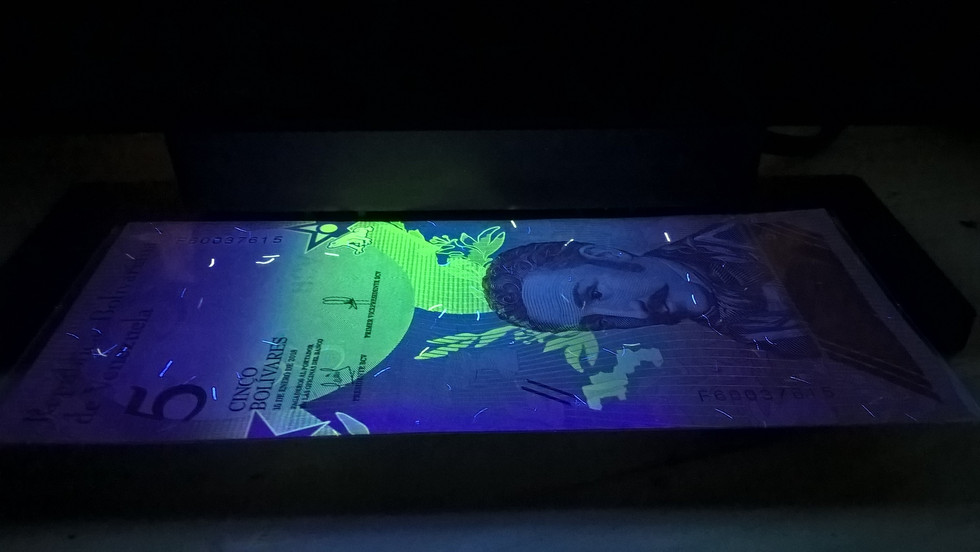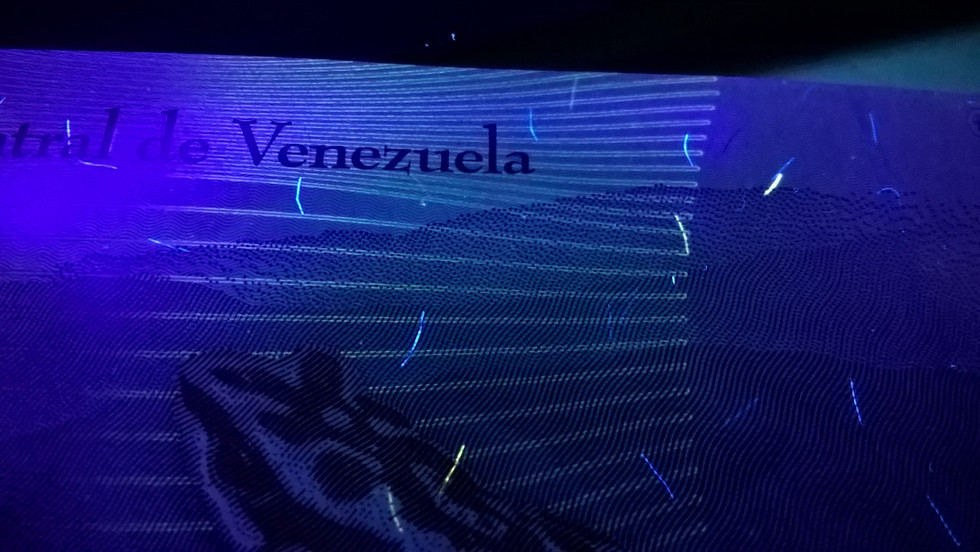This Venezuelan banknote represent the 2nd denomination of the Bolívar Soberano Series (2018). Bolívars are have been deemed essentially worthless, even within their home country. As rampant hyperinflation has caused all denominations, with the exception of the 500 Bolívares to be retired.
Despite this, Venezuelan Bolívars have found a new home. As an easily affordable item for beginning/young collectors. These collectors often become attracted, by the colorful illustrations of Venezuela’s wildlife. Often creating decorative displays, with the reverse side out. In honor of that tradition this note will be reviewed reverse first.
Reverse

The Reverse features an endangered Rancho Grande Harlequin Frog, also known as the Stripped Frog (Sapito Rayado), in Spanish. They inhabit the central Venezuelan Coastal Range and get their name from the Rancho Grande National Park. Harlequin Frog specimens have been encountered at elevations high as 2,400 m (7,900 ft) above sea level. The species was suspected to be extinct, for a span of 17 years. Beginning in 1986 and ending 2003, when a small population was encountered.
The suspected cause of the declining harlequin frog population is chytridiomycosis. An infectious amphibian disease caused by amphibian chytrid fungus. The effects of this fungus is currently poorly understood. As it inconsistently affects amphibian populations, throughout the world. Some populations become devastated, while others remain relatively unaffected. Even within the same species.
Rancho Grande
The background is an illustration of the Henri Pittier National Park (Rancho Grande). Created in 1937, Rancho Grande is the oldest of Venezuela's 47 national parks. It was renamed the Henri Pittier National Park in 1953, in honor of Swiss botanist Henri Pittier. Who classified over 30,000 native plants. The most studied portion of the park, is a 0.25 hectare (0.6 acre) research area. Despite its small size, the research zone contains 150 different species of trees. In addition, the park hosts at least 582 species of birds, representing 43% of all bird species in Venezuela, and 6% of the world's avian biodiversity.
The park provides a wide-range of recreational activities, ranging from tourist-orientated to relatively remote locations. The most popular being Choroni Beach, a tourist spot located at the foot of cloud forest mountains. The beach is accessible by a 50 km (32 mi) drive from Maracay, the capital of Aragua State. It's possible camp on the mountainous areas of the park. By requesting a special permit from INPARQUES (Venezuelan National Parks Institute).

Observe
The vertical observe features 19th Century revolutionary leader Jose Felix Ribas (1775-1815). Who served as an officer, under General Simón Bolívar. Jose Ribas is a recognized member of the Panteón Nacional de Venezuela (National Pantheon of Venezuela). As one of the hero of the Venezuelan War of Independence (1810-1823).
Countermeasures
Despite the low value of the Bolívar Soberano, the series utilizes numerous security measures. Both in visible and virtually hidden. The note's observe utilizes a thin security strip. It can be faintly made out, running along the note's center. The Soberano series alternates between standard and window security strips, throughout it's denominations.
The 2 forward dashes above the (red) serial number, are a denomination designator. Which alternates between the denominations, within the series. There is a 2-color light puzzle/registration element, below the (black) serial number. Blue (observe) and gold (reverse) segments merge, when back lit. Highlight a frog and star.The registration element and the surrounding area is UV sensitive.

Microprint
The near entirety of the note is covered in alternating lines and micro-print patterns. Where present the micro-text the reads “BCV5”, in sequence. The pattern repeats on all denominations, with the exception of the number (listed denomination). Below the obverse’s portrait is a micro-print pattern displaying "BCV". This feature is only repeated on the 500 Bolivar note.
Watermark
The watermark features Simón Bolívar, as seen on the 500 Bolívar Soberano note's observe. Below the watermark is BCV, in electrotyped text. Unfortunately the color pallet and erratic micro-print lines makes capturing the watermark difficult. Although it can be readily seen, in physical copies of the note.
Ultraviolet Gallery
2018 Bolívar Gallery (Observe)
(Gallery features all observe sides of the 2018 Bolívar Soberano)
2018 Bolívar Gallery (Reverse)
(Gallery features all reverse sides of the 2018 Bolívar Soberano)
Additional Notes
This note's dimensions are 156 × 69 mm (6.14 x 2.72in), standard for Bolívar Soberano Series.
The note's observe is a copy of Martín Tovar y Tovar's portrait, José Felix Ribas
Two separate Venezuelan municipalities are named in Ribas' honor. José Félix Ribas Municipality in Aragua and in Guárico.
In 2003, the Venezuelan government enacted Mission Ribas. An education program targeted at Venezuelan high school dropouts.










































Comments